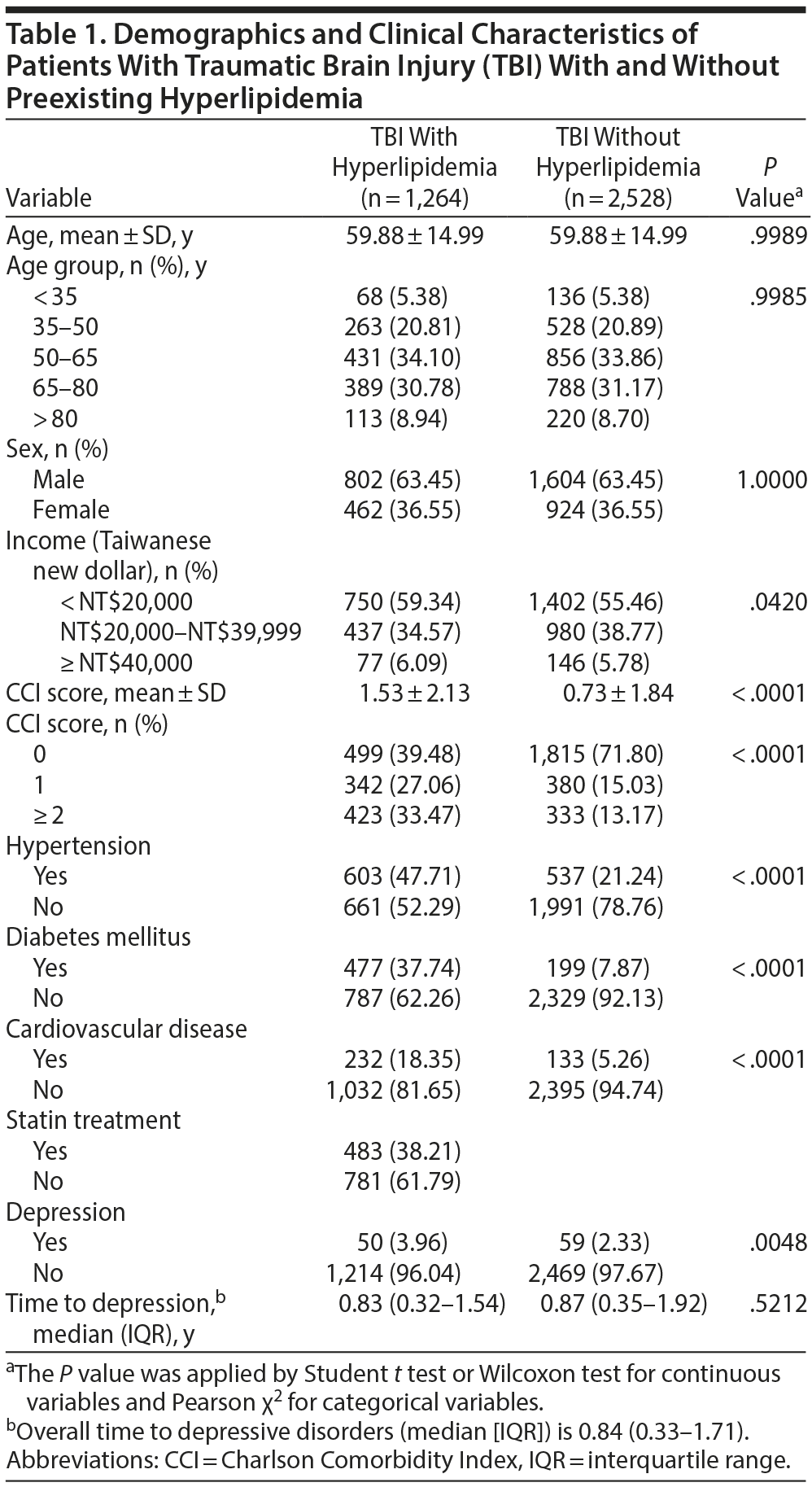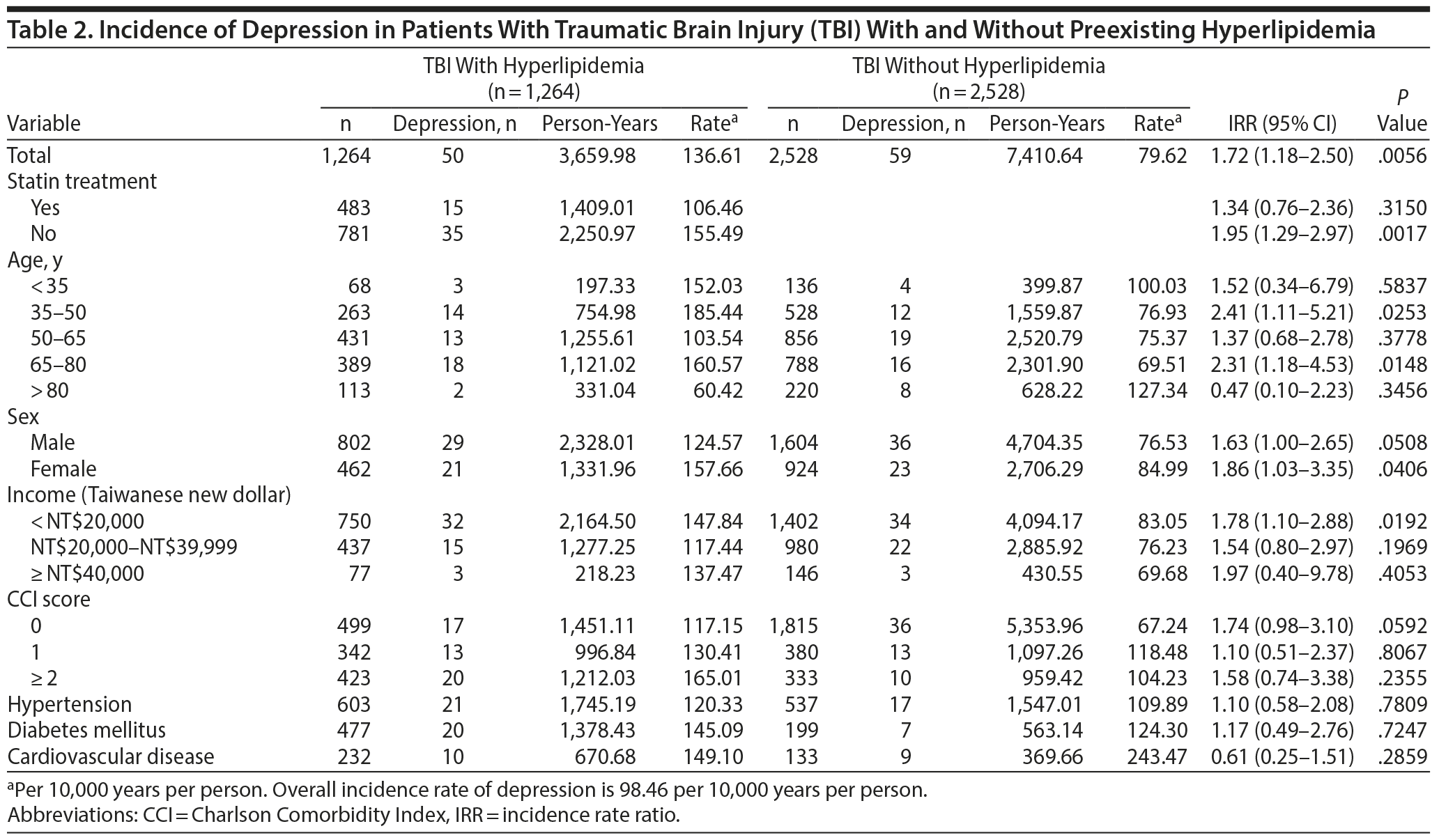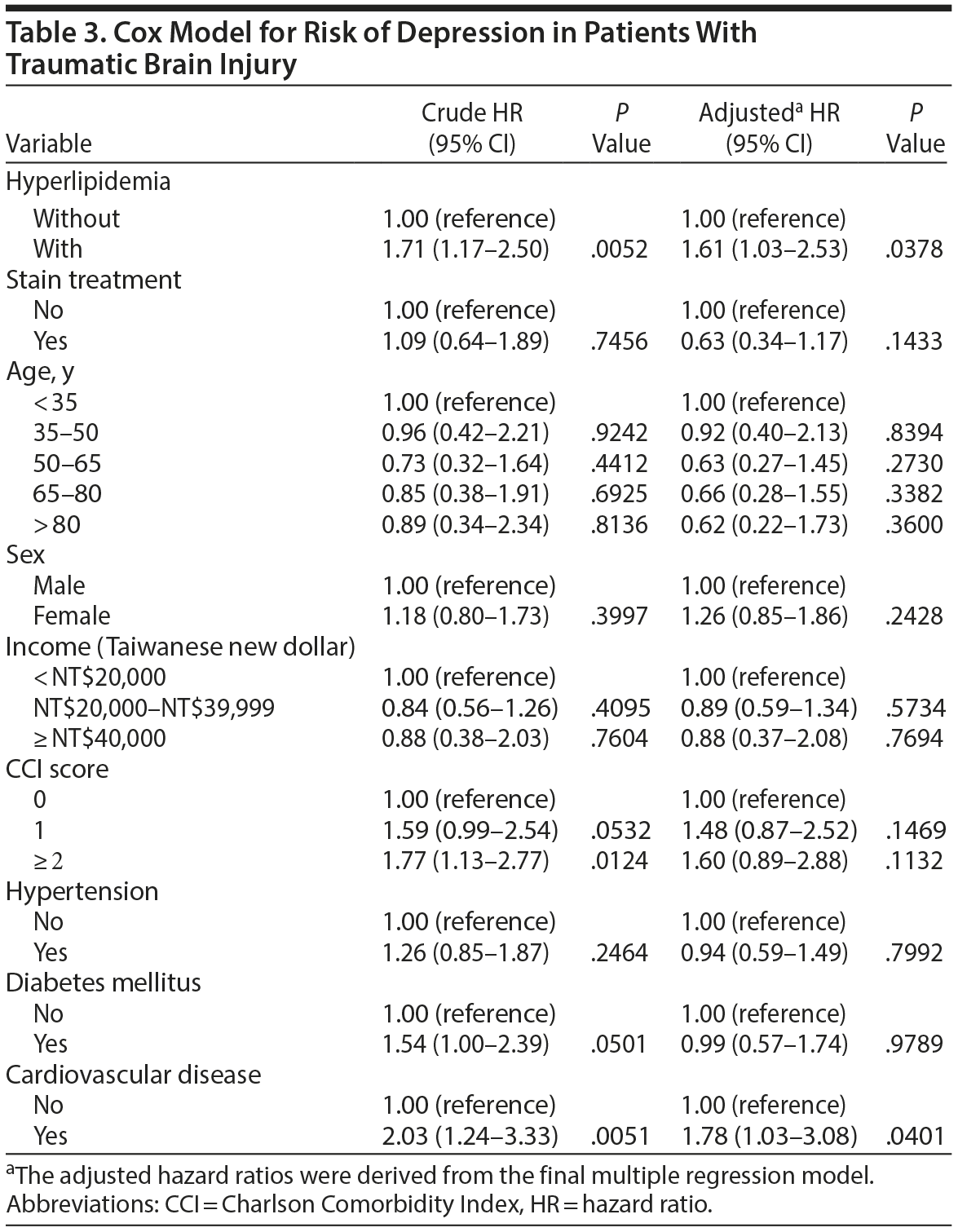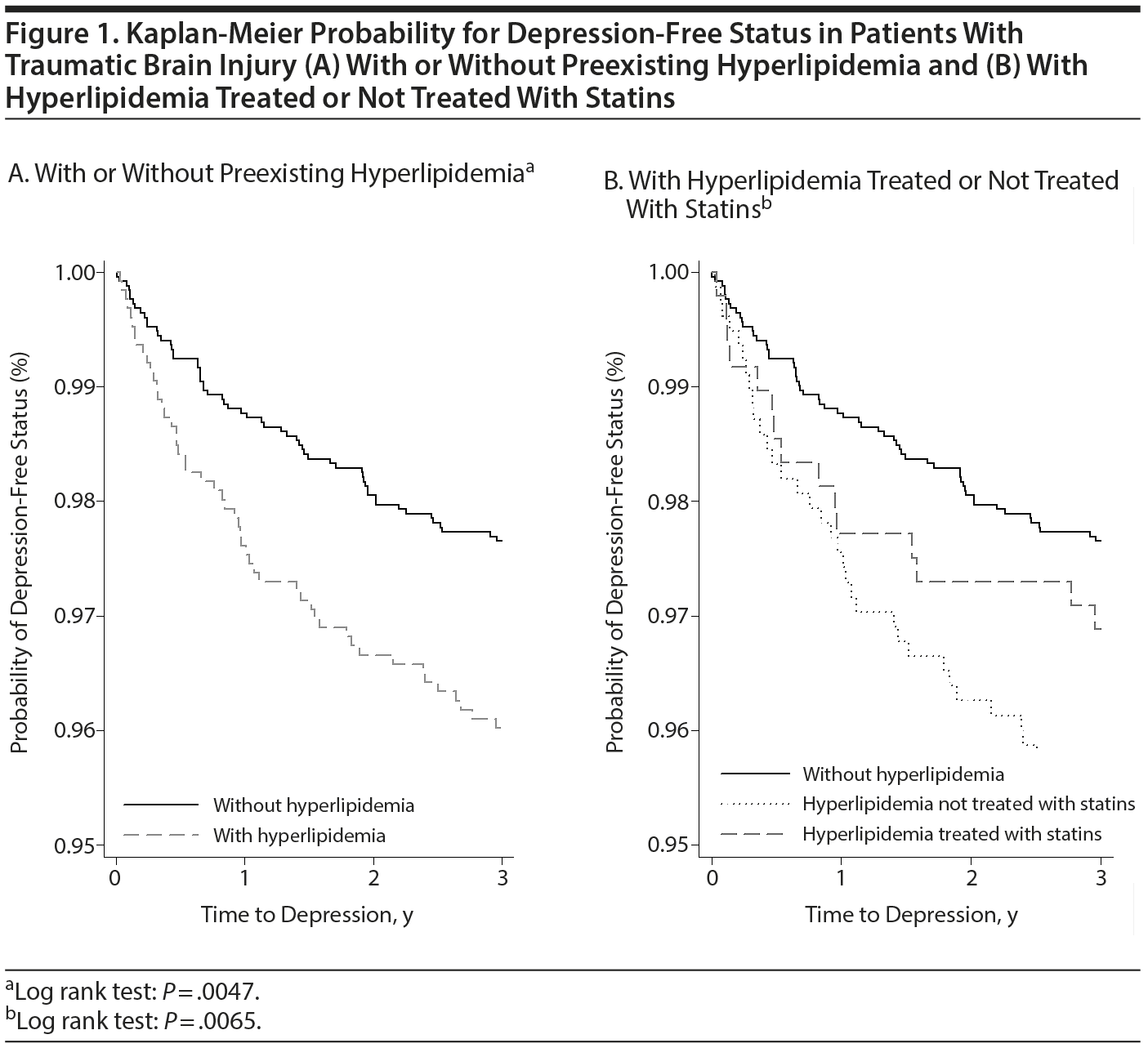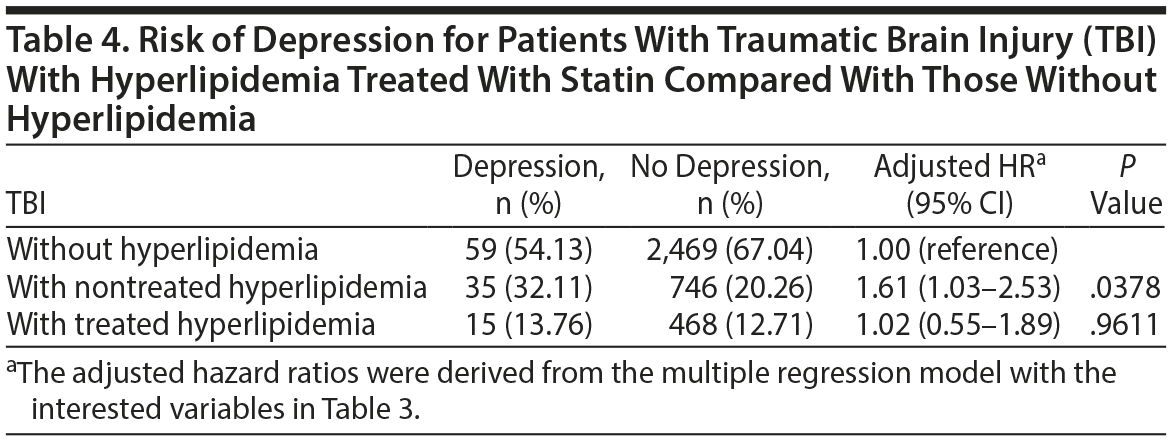Objective: Depression is a common complication after traumatic brain injury (TBI). This study aimed to evaluate the risk of hyperlipidemia for new-onset depression after TBI and the role of statin medications using a longitudinal population database.
Method: A matched longitudinal cohort study of 3,792 subjects (1,264 TBI patients [ICD-9-CM code: 801-804 and 850-854] with preexisting hyperlipidemia [ICD-9-CM code: 272.0, 272.1, 272.2, 272.4] and 2,528 age- and sex-matched TBI patients without hyperlipidemia) was conducted using the Taiwan Longitudinal Health Insurance Database from January 2001 to December 2008. The incidence and hazard ratios (HRs) for the development of new-onset depression (ICD-9-CM code: 296.2X-296.3X, 300.4, and 311.X) after TBI were compared between the 2 groups.
Results: The incidence rate of depression in TBI with preexisting hyperlipidemia was 136.61 per 10,000 person-years. TBI patients with preexisting hyperlipidemia had a 1.72-fold increased incidence rate ratio compared with those without hyperlipidemia (P = .0056). A Cox model showed hyperlipidemia to be an independent predictor of depression (HR = 1.61; 95% CI, 1.03-2.53). TBI patients with hyperlipidemia who were not treated with statins experienced a 1.95-fold incidence risk ratio (P = .0017) and higher risk of new-onset depression (HR = 1.61; 95% CI, 1.03-2.53) compared to TBI patients without hyperlipidemia.
Conclusions: Preexisting hyperlipidemia could be an independent predictor of new-onset depression in TBI patients, and TBI patients with preexisting hyperlipidemia who were not treated with statins presented a higher risk of new-onset depression than TBI patients without hyperlipidemia. Our findings may provide some insight into the important role of statin medications in the development of new-onset depression in patients with traumatic brain injury.
This work may not be copied, distributed, displayed, published, reproduced, transmitted, modified, posted, sold, licensed, or used for commercial purposes. By downloading this file, you are agreeing to the publisher’s Terms & Conditions.
Increased Risk of New-Onset Depression in Patients With Traumatic Brain Injury and Hyperlipidemia:
The Important Role of Statin Medications

ABSTRACT
Objective: Depression is a common complication after traumatic brain injury (TBI). This study aimed to evaluate the risk of hyperlipidemia for new-onset depression after TBI and the role of statin medications using a longitudinal population database.
Method: A matched longitudinal cohort study of 3,792 subjects (1,264 TBI patients [ICD-9-CM code: 801-804 and 850-854] with preexisting hyperlipidemia [ICD-9-CM code: 272.0, 272.1, 272.2, 272.4] and 2,528 age- and sex-matched TBI patients without hyperlipidemia) was conducted using the Taiwan Longitudinal Health Insurance Database from January 2001 to December 2008. The incidence and hazard ratios (HRs) for the development of new-onset depression (ICD-9-CM code: 296.2X-296.3X, 300.4, and 311.X) after TBI were compared between the 2 groups.
Results: The incidence rate of depression in TBI with preexisting hyperlipidemia was 136.61 per 10,000 person-years. TBI patients with preexisting hyperlipidemia had a 1.72-fold increased incidence rate ratio compared with those without hyperlipidemia (P = .0056). A Cox model showed hyperlipidemia to be an independent predictor of depression (HR = 1.61; 95% CI, 1.03-2.53). TBI patients with hyperlipidemia who were not treated with statins experienced a 1.95-fold incidence risk ratio (P = .0017) and higher risk of new-onset depression (HR = 1.61; 95% CI, 1.03-2.53) compared to TBI patients without hyperlipidemia.
Conclusions: Preexisting hyperlipidemia could be an independent predictor of new-onset depression in TBI patients, and TBI patients with preexisting hyperlipidemia who were not treated with statins presented a higher risk of new-onset depression than TBI patients without hyperlipidemia. Our findings may provide some insight into the important role of statin medications in the development of new-onset depression in patients with traumatic brain injury.
J Clin Psychiatry 2016;77(4):505-511
dx.doi.org/10.4088/JCP.14m09749
© Copyright 2016 Physicians Postgraduate Press, Inc.
aDepartment of Neurosurgery, Chi-Mei Medical Center, Liouying, Tainan, Taiwan
bDepartments of Medical Research and cPsychiatry, Chi-Mei Medical Center, Tainan, Taiwan
dDepartment of Hospital and Health Care Administration, Chia Nan University of Pharmacy and Science, Tainan, Taiwan
eDepartment of Public Health, College of Medicine, National Cheng Kung University, Tainan, Taiwan
fDepartments of Biotechnology and gChild Care, Southern Taiwan University of Science and Technology, Taiwan
‘ ¡Drs Wee and Ho contributed equally.
*Corresponding author: Jinn-Rung Kuo, MD, PhD, Department of Neurosurgery, Traumatic Brain Center, Chi -Mei Medical Center, #901, Jong-Hwa Rd, Yung-Kung City, 710, Tainan, Taiwan, ([email protected]).
Traumatic brain injury (TBI) is a leading cause of neurologic deficits, cognitive impairment, and psychiatric disorders in survivors.1 It has become a major public issue for an estimated 3.17 million individuals in the United States2 and was associated with 3.39 times the medical costs in TBI patients with psychiatric disorders compared to those without psychiatric disorders.3
Among these psychiatric disorders, depression is the most common psychiatric complication of TBI and ranges from 6% to 77%, with variations according to the studied population and the diagnostic criteria or rating instruments used.4-7 Depression is associated with a 3-fold increase of medical regimens in patients with chronic illness or comorbidities.8 Age,9 sex,10 socioeconomic status,11 cardiovascular disease,12 hypertension,13 diabetes mellitus,14 hyperlipidemia,15,16 and TBI17 are risk factors associated with depressive disorder.
Hyperlipidemia is a common symptom in the general population. From the different population surveys,18,19 the range of hyperlipidemia prevalence was from 19.9% to 33.5% among adults aged ≥ 20 years. Hyperlipidemia was also related to the risk of cardiovascular disease,20 diabetes mellitus,21 and hypertension,22 which are all risk factors for depression. Furthermore, some evidence indicate that statin medications, an antihyperlipidemic agent, has neuroprotective effects on the hippocampus, which may be associated with the depression developed in TBI animal models.23,24 Therefore, hyperlipidemia may play a role in the development of new-onset depression after TBI. Neurosurgeons can expect to see more TBI patients who have preexisting hyperlipidemia in daily practice. We suggest that paying more attention to these factors associated with depression would help clinicians have a deeper understanding of the sequelae in TBI patients.
No studies have evaluated the association between preexisting hyperlipidemia and the risk of new-onset depression in TBI patients when considering the associated risk factors simultaneously. Therefore, the aim of this study was to evaluate the incidence and risk ratio of preexisting hyperlipidemia, including statin-treated and non-statin-treated, for the development of new-onset depression in TBI patients using data from the nationwide database of the National Health Insurance (NHI) Program in Taiwan (1997-2011). We propose that awareness of the incidence and risk factors for new-onset depression in TBI patients can improve one’s understanding of the sequelae of brain injury and patient treatment, the rehabilitation protocol, and preventive medicine strategies.
METHOD
Data Source
Taiwan’s National Health Insurance Research Database (NHIRD) is an inpatient and outpatient medical benefit claims database that includes diagnostic codes based on the International Classification of Diseases, Ninth Revision, Clinical Modification (ICD-9-CM), and prescription details. Of Taiwan’s 23 million residents, 99% were covered by the NHI Program. For the purpose of medical research, the National Health Research Institute has released a database of medical claims of 1,000,000 random subjects based on the 2000 reimbursement data (Longitudinal Health Insurance Database 2000). Each individual’s unique personal identification number in NHIRD has been interlinked. The study obtained ethics approval from institutional review board of Chi-Mei Medical Center, Tainan, Taiwan.
Patient Selection and Definition
Traumatic brain injury (ICD-9-CM code: 801-804 and 850-854) inpatients from January 2001 to December 2008 were enrolled, and those with preexisting hyperlipidemia were defined as cases. Controls were TBI patients without hyperlipidemia before and after their TBI diagnosis. The presence of hyperlipidemia (ICD-9-CM code: 272.0, 272.1, 272.2, 272.4) was defined as at least 3 outpatient visits within 1 year or 1 inpatient admission for the disorder. For examining the incidence of related depressive disorders between cases and controls, all of the patients were followed for at least 3 years until December 31, 2011. The diagnosis of depression was based on the criteria of the ICD-9-CM codes such as major depressive disorder, single episode (ICD-9-CM code: 296.2X); major depressive disorder, recurrent episode (ICD-9-CM code: 296.3X); dysthymic disorder (ICD-9-CM code: 300.4); and depressive disorder, not elsewhere classified (ICD-9-CM code: 311.X). The event of depressive disorders was defined as at least 3 outpatient visits within 1 year or 1 inpatient admission with a depressive disorders diagnosis. To minimize potential confounding in estimating the incidence of depressive disorders, patients with existing depressive disorders before their TBI diagnosis or those who died within 1 month after their TBI diagnosis were excluded. For each case, 2 controls matched by age and sex were selected.

- The association between preexisting hyperlipidemia and the risk of new-onset depression in patients with traumatic brain injury (TBI) is not established.
- Preexisting hyperlipidemia could be an independent predictor of new-onset depression in TBI patients.
- Statin-treated hyperlipidemia patients presented a lower risk of new-onset depression than did those who received no statins or had no hyperlipidemia in TBI patients.
The baseline covariates included age, sex, income, Charlson Comorbidity Index (CCI)25 score, hyperlipidemia-related comorbidities, and use of a statin medication. Age was grouped into 5 categories: less than 35, 35-50, 50-65, 65-80, and older than 80 years. The patients’ income, based on the insurance amount, was classified into 3 categories: less than $640 (NT$20,000), $640-$1,280 (NT$20,000-NT$39,999), and $1,281 (NT$40,000) or more. The CCI was used to summarize important concomitant diseases based on the ICD-9-CM codes.26 Hyperlipidemia-related comorbidities were hypertension (ICD-9-CM code: 401-405, 437.2, and 362.11), cardiovascular disease (ICD-9-CM code: 410-414), and diabetes mellitus (ICD-9-CM code: 250, 357.2, 362.0, and 366.41). The comorbidities of the CCI and hyperlipidemia-related comorbidities were defined as at least 3 outpatient visits or 1 inpatient admission before 1 year of first TBI diagnosis for a given illness. The medical records for these patients screened for having used statins at least 3 times or longer than 6 months were identified by treatment of hyperlipidemia.
Statistical Analysis
The differences in baseline characteristics between the TBI patients with preexisting hyperlipidemia and those without were evaluated using Student t tests and Pearson χ2 tests for continuous and categorical variables, respectively. The incidence rate of depressive disorders was calculated by dividing the number of the TBI patients with depressive disorders by the total person-years and was reported as events per 10,000 person-years of follow-up. The incidence rate ratios (IRRs) of depression with 95% confidence intervals (CIs) between the TBI patients with preexisting hyperlipidemia and those without were estimated by a Poisson regression. The Kaplan-Meier plot was presented to describe the proportion of patients who had depressive disorders, and the log-rank test was used to compare the risk difference between the 2 groups. A Cox proportional hazard regression was applied to estimate the relative risks of depressive disorders adjusted for potential confounders. A P value of < .05 was considered significant. SAS 9.3 for Windows (SAS Institute, Inc; Cary, North Carolina) was used for all statistical analyses. Kaplan-Meier curves were plotted using STATA (version 12; StataCorp; College Station, Texas).
RESULTS
A total of 3,792 patients were enrolled in this study. Table 1 presents the distribution of the baseline characteristics between the TBI patients with and without hyperlipidemia. After matching by age and sex, the distribution of income, CCI, and comorbidities showed significant differences between the TBI patients with and without hyperlipidemia. In addition, 3.96% and 2.33% of the TBI patients with and without hyperlipidemia, respectively, developed new-onset depression during the follow-up period. The overall follow-up median time was 0.84 years (interquartile range [IQR] = 0.33-1.71). The TBI patients with hyperlipidemia developed new-onset depression (median = 0.83 years, IQR = 0.32-1.54) earlier than those without (median = 0.87 years, IQR = 0.35-1.92).
The incidence of depression in TBI patients with hyperlipidemia was 1.72 times higher than in TBI patients without hyperlipidemia (P = .0056) (Table 2). Of the TBI patients aged 35-50 and 65-80 years, those with hyperlipidemia had a risk of depression 2.41 and 2.31 times higher, respectively, than those without hyperlipidemia. The female TBI patients with hyperlipidemia were more likely to develop depression than those without hyperlipidemia. Of the TBI patients with low income, those with hyperlipidemia had a significantly higher incidence of new-onset depression than those without hyperlipidemia (IRR = 1.78, 95% CI, 1.10-2.88). Moreover, of the TBI patients without comorbidities before their surgery, those with hyperlipidemia showed 1.74 times the incidence risk of new-onset depression compared with those without hyperlipidemia.
After we controlled for potential confounders, hyperlipidemia and cardiovascular disease significantly increased the risk of depression, with hazard ratios (HRs) of 1.61 (95% CI, 1.03-2.53) and 1.78 (95% CI, 1.03-3.08), respectively (Table 3). The Kaplan-Meier plots show that TBI patients with hyperlipidemia had a significantly higher risk of depression than did those without (log rank: P = .0047) (Figure 1A). Table 4 presents the risk of new-onset depression stratified by the treatment of statin in TBI patients. TBI patients with preexisting hyperlipidemia not treated with statins had a 1.61-fold (95% CI, 1.03-2.53) increased hazard of depression compared with TBI patients without hyperlipidemia (P = .0378). Figure 1B reveals that TBI patients with preexisting hyperlipidemia not treated with statins had a significantly higher risk of depression during the follow-up period than did TBI patients without hyperlipidemia.
DISCUSSION
To our knowledge, this is the first study to present that preexisting hyperlipidemia is an independent risk factor of developing new-onset depression after TBI, especially in patients who were never treated with statins before TBI. This information will hopefully serve as a foundation for future studies on antidepressant therapy for TBI.
In the general population, hyperlipidemia,15,16 age,9 sex,10 socioeconomic status,11 cardiovascular disease,12 hypertension,13 and diabetes mellitus14 are risk factors of developing depression. In our study, we further elucidated these relationships and provided novel findings that preexisting hyperlipidemia is an independent risk factor of new-onset depression after TBI when adjusting for all potential confounders. Furthermore, hyperlipidemia patients who received statins exhibited a significantly lower risk for depression than did those who did not receive statins. Therefore, we want to emphasize that hyperlipidemia’s neuropathological effects on the development of depression after TBI are worth investigating.
Former studies have shown that women are at a higher risk for depressive disorder than men. Kessler et al27 indicated that women are approximately 1.7 times as likely as men to report a lifetime history of depression. The possible explanations of the greater susceptibility of women to depression may be multifactorial, such as coping styles, responses to stress, and endocrine influences.28-30 Consistent with previous reports, our study further found that the effect of hyperlipidemia on women was larger than that on men (IRR [women] = 1.86; 95% CI, 1.03-3.35; vs IRR [men] = 1.63; 95% CI, 1.00-2.65). However, the definite mechanisms in our cases of new-onset depression are unclear; nevertheless, we propose that hyperlipidemia could have a more important role as a predisposing factor in depression pathology after TBI for women than for men . This information can provide strategic reference for depression prevention after TBI.
As shown in Table 1, the percentages of TBI patients with hyperlipidemia were higher in low-income (< NT$20,000, 59.34%) and high-income (≥ NT$40,000, 6.09%) patients than in those of TBI patients without hyperlipidemia. These variations support the previous findings31 that household income levels are associated with health insurance status, medical care use, health, life style, and employment. For example, people with a relatively high income may have the opportunity to search for relatively better health care and, thus, have an artificially increased awareness rate of hyperlipidemia in our study. People with a relatively low income level may be linked to food insecurity, which is the inability to afford nutritionally adequate and safe foods, and, thus, are associated with hyperlipidemia.32 Several studies have shown that low income is associated with increased depression in type 2 diabetes and other chronic illnesses33 among patients with chronic obstructive pulmonary disease.34 Pabayo et al35 additionally indicated that living in a higher income inequality region could increase the risk of the depression. As shown in Table 2, low income TBI patients with preexisting hyperlipidemia showed a significantly higher incidence of depression compared to those without hyperlipidemia (IRR = 1.78; 95% CI, 1.10-2.88; P = .0406).
We further examined if the treatment of hyperlipidemia prior to a TBI episode would affect the risk of posttraumatic new-onset depression. Statins are used mainly for the treatment of hyperlipidemia, but the relationship between depression and statins is not consistent. Simvastatin was found to be associated with decreases in positive affect in elderly people.36 However, another study37 showed that hyperlipidemia is associated with increased risk of depression and that the use of statins decreases the risk of depression in patients with hyperlipidemia. This discrepancy maybe due to the final serum cholesterol level since low cholesterol concentration is associated with depression.38,39 In our study, we found that preexisting hyperlipidemia is a risk factor of new-onset depression and that using statins could decrease the probability of developing posttraumatic new-onset depression. From the trend of development of new-onset depression (Figure 1B), we also found that, in the early stage, there is no difference in the probability of new-onset depression-free status between statin-treated and non-statin-treated groups for TBI patients with preexisting hyperlipidemia. However, around 1-year later, the group not treated with statins presented a significantly higher risk of new-onset depression compared to the statin-treated group. In addition, the finding of no difference in the risk of new-onset depression between TBI patients without hyperlipidemia and statin-treated TBI patients implies that statins may play a critical role in the development of new-onset depression. Thus, the findings could provide some insights into the important role of preexisting hyperlipidemia in the development of new-onset depression in TBI patients. We also suggest that evaluating the lipid profile in the acute stage to prevent depression developing later may be a promising strategy in the neurotrauma field.
Our study has several strengths. It is a population-matched cohort study that investigated the effect of prehyperlipidemia on new-onset depression among TBI patients. Based on the population database, the large sample size and long duration of follow-up made it possible to examine the incidence and risk factors associated with depression. The prospective association between hyperlipidemia and depression in our study design allowed the direction of the effect to be explored. The finding that hyperlipidemia was an independent risk factor of new-onset depression after TBI may indicate an important role in preventive medicine.
However, several limitations in our study should be considered. First, the diagnoses relied on the claims data and the ICD-9-CM diagnosis, and, thus, some disease misclassifications may exist. Second, the true outcome (new-onset depression) could be underestimated because of the underdiagnosis and undertreatment of depression in the claims data. Third, we did not evaluate smoking, obesity, or alcohol, which may influence the development of depression after TBI. Thus, other potential contributors to our results may be undetected. Fourth, information on the severity of TBI (such as Glasgow coma scale) and hyperlipidemia, which may be associated with the occurrence of depression, was unavailable. Although some studies have indicated that the severity of TBI may relate to the length of intensive care unit stay40-42 or TBI classification into 2 categories based on the ICD-9-CM: mild brain injury (ICD-9-CM 850) and severe brain injury (ICD-9-CM 851-854),43 the potential limitations of TBI severity definition were still existing. However, some studies44,45 have indicated that the severity of TBI was not associated with emotional dysfunction in early postsurgery periods. Thus, this evidence supports the view that hyperlipidemia may be an important risk factor of depression in TBI patients. In the future research, it would be of interest to investigate whether the severity of TBI may affect the association between hyperlipidemia and the long-term effect of the new-onset depression. Finally, we expect this study underestimated the numbers of TBI patients without hyperlipidemia because the amount of undiagnosed disease in those without any access to health care is impossible to report.
CONCLUSIONS
Preexisting hyperlipidemia is an independent predictor of new-onset depression in TBI patients, even when controlling for other demographic and clinical covariates. TBI patients with hyperlipidemia, especially for those untreated with statin medications, had a significantly higher risk than did those without hyperlipidemia. Future studies should investigate the role of statins in TBI-induced depression syndromes to determine the effect and safety of long-term statin use.
Submitted: December 22, 2014; accepted March 26, 2015.
Online first: March 1, 2016.
Author contributions: Drs Kuo, J-J Wang, and Ho conceived and designed the experiments. Drs Wee, Kuo, and Chio performed the experiments. Drs Ho, Liang, and Kuo analyzed the data. Drs Hsieh, J-J Wang, Chio, and Chang contributed reagents/materials/analysis tools. Drs Ho, C-C Wang, Liang, and Kuo wrote the paper.
Potential conflicts of interest: None reported.
Funding/support: This work was supported by Chi-Mei Medical Center grant number CMFHR10337.
Role of the sponsor: The sponsors had no role in the design and conduct of the study; collection, management, analysis, and interpretation of the data; and preparation , review, or approval of the manuscript.
Disclaimer: The interpretation and conclusions contained herein do not represent those of the National Health Insurance Administration, the Ministry of Health and Welfare, or the National Health Research Institutes.
Acknowledgments: This study is based in part on data from the National Health Insurance Research Database provided by the National Health Insurance Administration, Ministry of Health and Welfare and managed by the National Health Research Institutes.
Additional information: The National Health Insurance Research Database was provided by the National Health Insurance Administration, Ministry of Health and Welfare, Taiwan, and is managed by the National Health Research Institutes. Information on how to access the data can be found at http://nhird.nhri.org.tw/en/index.html.
REFERENCES
1. Adamides AA, Winter CD, Lewis PM, et al. Current controversies in the management of patients with severe traumatic brain injury. ANZ J Surg. 2006;76(3):163-174. PubMed doi:10.1111/j.1445-2197.2006.03674.x
2. Zaloshnja E, Miller T, Langlois JA, et al. Prevalence of long-term disability from traumatic brain injury in the civilian population of the United States, 2005. J Head Trauma Rehabil. 2008;23(6):394-400. PubMed doi:10.1097/01.HTR.0000341435.52004.ac
3. Rockhill CM, Jaffe K, Zhou C, et al. Health care costs associated with traumatic brain injury and psychiatric illness in adults. J Neurotrauma. 2012;29(6):1038-1046. PubMed doi:10.1089/neu.2010.1562
4. Rutland-Brown W, Langlois JA, Thomas KE, et al. Incidence of traumatic brain injury in the United States, 2003. J Head Trauma Rehabil. 2006;21(6):544-548. PubMed doi:10.1097/00001199-200611000-00009
5. van Reekum R, Bolago I, Finlayson MA, et al. Psychiatric disorders after traumatic brain injury. Brain Inj. 1996;10(5):319-327. PubMed doi:10.1080/026990596124340
6. Jorge R, Robinson RG. Mood disorders following traumatic brain injury. Int Rev Psychiatry. 2003;15(4):317-327. PubMed doi:10.1080/09540260310001606700
7. Rapoport MJ. Depression following traumatic brain injury: epidemiology, risk factors and management. CNS Drugs. 2012;26(2):111-121. PubMed doi:10.2165/11599560-000000000-00000
8. DiMatteo MR, Lepper HS, Croghan TW. Depression is a risk factor for noncompliance with medical treatment: meta-analysis of the effects of anxiety and depression on patient adherence. Arch Intern Med. 2000;160(14):2101-2107. PubMed doi:10.1001/archinte.160.14.2101
9. Harpole LH, Williams JW Jr, Olsen MK, et al. Improving depression outcomes in older adults with comorbid medical illness. Gen Hosp Psychiatry. 2005;27(1):4-12. PubMed
10. Oquendo MA, Turret J, Grunebaum MF, et al. Sex differences in clinical predictors of depression: a prospective study. J Affect Disord. 2013;150(3):1179-1183. PubMed doi:10.1016/j.jad.2013.05.010
11. Leone T, Coast E, Narayanan S, et al. Diabetes and depression comorbidity and socio-economic status in low and middle income countries (LMICs): a mapping of the evidence. Global Health. 2012;8(1):39. PubMed doi:10.1186/1744-8603-8-39
12. Hare DL, Toukhsati SR, Johansson P, et al. Depression and cardiovascular disease: a clinical review. Eur Heart J. 2014;35(21):1365-1372. PubMed doi:10.1093/eurheartj/eht462
13. McElroy SL, Keck PE Jr. Metabolic syndrome in bipolar disorder: a review with a focus on bipolar depression. J Clin Psychiatry. 2014;75(1):46-61. PubMed doi:10.4088/JCP.13r08634
14. Pan A, Lucas M, Sun Q, et al. Increased mortality risk in women with depression and diabetes mellitus. Arch Gen Psychiatry. 2011;68(1):42-50. PubMed doi:10.1001/archgenpsychiatry.2010.176
15. Kamezaki F, Sonoda S, Nakata S, et al. Elevated depressive symptoms are associated with hypertriglyceridemia in Japanese male workers. Intern Med. 2011;50(21):2485-2490. PubMed doi:10.2169/internalmedicine.50.5667
16. van Reedt Dortland AK, Giltay EJ, van Veen T, et al. Associations between serum lipids and major depressive disorder: results from the Netherlands Study of Depression and Anxiety (NESDA). J Clin Psychiatry. 2010;71(6):729-736. PubMed doi:10.4088/JCP.08m04865blu
17. Bombardier CH, Fann JR, Temkin NR, et al. Rates of major depressive disorder and clinical outcomes following traumatic brain injury. JAMA. 2010;303(19):1938-1945. PubMed doi:10.1001/jama.2010.599
18. Chang H-Y, Yeh W-T, Chang Y-H, et al. Prevalence of dyslipidemia and mean blood lipid values in Taiwan: results from the Nutrition and Health Survey in Taiwan (NAHSIT, 1993-1996). Chin J Physiol. 2002;45(4):187-197. PubMed
19. Centers for Disease Control and Prevention (CDC). Vital signs: prevalence, treatment, and control of high levels of low-density lipoprotein cholesterol—United States, 1999-2002 and 2005-200. MMWR Morb Mortal Wkly Rep. 2011;60(4):109-114. PubMed
20. Nelson RH. Hyperlipidemia as a risk factor for cardiovascular disease. Prim Care. 2013;40(1):195-211. PubMed doi:10.1016/j.pop.2012.11.003
21. Krentz AJ. Lipoprotein abnormalities and their consequences for patients with type 2 diabetes. Diabetes Obes Metab. 2003;5(suppl 1):S19-S27. PubMed doi:10.1046/j.1462-8902.2003.0310.x
22. Kawamoto R, Tabara Y, Kohara K, et al. Increased high-density lipoprotein cholesterol is associated with a high prevalence of pre-hypertension and hypertension in community-dwelling persons. Endocrine. 2012;42(2):321-328. PubMed doi:10.1007/s12020-012-9625-z
23. Can OD, Ulupınar E, זzkay UD, et al. The effect of simvastatin treatment on behavioral parameters, cognitive performance, and hippocampal morphology in rats fed a standard or a high-fat diet. Behav Pharmacol. 2012;23(5-6):582-592. PubMed doi:10.1097/FBP.0b013e328356c3f2
24. Lu D, Qu C, Goussev A, et al. Statins increase neurogenesis in the dentate gyrus, reduce delayed neuronal death in the hippocampal CA3 region, and improve spatial learning in rat after traumatic brain injury. J Neurotrauma. 2007;24(7):1132-1146. PubMed doi:10.1089/neu.2007.0288
25. Charlson ME, Pompei P, Ales KL, et al. A new method of classifying prognostic comorbidity in longitudinal studies: development and validation. J Chronic Dis. 1987;40(5):373-383. PubMed doi:10.1016/0021-9681(87)90171-8
26. Deyo RA, Cherkin DC, Ciol MA. Adapting a clinical comorbidity index for use with ICD-9-CM administrative databases. J Clin Epidemiol. 1992;45(6):613-619. PubMed doi:10.1016/0895-4356(92)90133-8
27. Kessler RC, McGonagle KA, Swartz M, et al. Sex and depression in the National Comorbidity Survey, I: lifetime prevalence, chronicity and recurrence. J Affect Disord. 1993;29(2-3):85-96. PubMed doi:10.1016/0165-0327(93)90026-G
28. Oetting ER. Primary socialization theory. developmental stages, spirituality, government institutions, sensation seeking, and theoretical implications, V. Subst Use Misuse. 1999;34(7):947-982. PubMed doi:10.3109/10826089909039389
29. Kaufert PA, Gilbert P, Tate R. The Manitoba Project: a re-examination of the link between menopause and depression. Maturitas. 2008;61(1-2):54-66. PubMed doi:10.1016/j.maturitas.2008.09.009
30. Llaneza P, Garc×a-Portilla MP, Llaneza-Suárez D, et al. Depressive disorders and the menopause transition. Maturitas. 2012;71(2):120-130. PubMed doi:10.1016/j.maturitas.2011.11.017
31. Hadley J. Sicker and poorer—the consequences of being uninsured: a review of the research on the relationship between health insurance, medical care use, health, work, and income. Med Care Res Rev. 2003;60(2 suppl):3S-75S, discussion 76S-112S. PubMed doi:10.1177/1077558703254101
32. Seligman HK, Laraia BA, Kushel MB. Food insecurity is associated with chronic disease among low-income NHANES participants. J Nutr. 2010;140(2):304-310. PubMed doi:10.3945/jn.109.112573
33. Thomas J, Jones G, Scarinci I, et al. A descriptive and comparative study of the prevalence of depressive and anxiety disorders in low-income adults with type 2 diabetes and other chronic illnesses. Diabetes Care. 2003;26(8):2311-2317. PubMed doi:10.2337/diacare.26.8.2311
34. Tsai TY, Livneh H, Lu MC, et al. Increased risk and related factors of depression among patients with COPD: a population-based cohort study. BMC Public Health. 2013;13(1):976. PubMed doi:10.1186/1471-2458-13-976
35. Pabayo R, Kawachi I, Gilman SE. Income inequality among American states and the incidence of major depression. J Epidemiol Community Health. 2014;68(2):110-115. PubMed
36. Morales K, Wittink M, Datto C, et al. Simvastatin causes changes in affective processes in elderly volunteers. J Am Geriatr Soc. 2006;54(1):70-76. PubMed doi:10.1111/j.1532-5415.2005.00542.x
37. Chuang C-S, Yang T-Y, Muo C-H, et al. Hyperlipidemia, statin use and the risk of developing depression: a nationwide retrospective cohort study. Gen Hosp Psychiatry. 2014;36(5):497-501. PubMed doi:10.1016/j.genhosppsych.2014.05.008
38. Aijפnseppפ S, Kivinen P, Helkala EL, et al. Serum cholesterol and depressive symptoms in elderly Finnish men. Int J Geriatr Psychiatry. 2002;17(7):629-634. PubMed doi:10.1002/gps.666
39. Fang CY, Egleston BL, Gabriel KP, et al. Depressive symptoms and serum lipid levels in young adult women. J Behav Med. 2013;36(2):143-152. PubMed doi:10.1007/s10865-012-9409-1
40. Higgins TL, McGee WT, Steingrub JS, et al. Early indicators of prolonged intensive care unit stay: impact of illness severity, physician staffing, and pre-intensive care unit length of stay. Crit Care Med. 2003;31(1):45-51. PubMed doi:10.1097/00003246-200301000-00007
41. Miller RS, Patton M, Graham RM, et al. Outcomes of trauma patients who survive prolonged lengths of stay in the intensive care unit. J Trauma. 2000;48(2):229-234. PubMed doi:10.1097/00005373-200002000-00006
42. Taylor MD, Tracy JK, Meyer W, et al. Trauma in the elderly: intensive care unit resource use and outcome. J Trauma. 2002;53(3):407-414. PubMed doi:10.1097/00005373-200209000-00001
43. Yeh C-C, Chen T-L, Hu C-J, et al. Risk of epilepsy after traumatic brain injury: a retrospective population-based cohort study. J Neurol Neurosurg Psychiatry. 2013;84(4):441-445. PubMed doi:10.1136/jnnp-2012-302547
44. Jamora CW, Young A, Ruff RM. Comparison of subjective cognitive complaints with neuropsychological tests in individuals with mild vs more severe traumatic brain injuries. Brain Inj. 2012;26(1):36-47. PubMed doi:10.3109/02699052.2011.635352
45. Rapoport M, McCauley S, Levin H, et al. The role of injury severity in neurobehavioral outcome 3 months after traumatic brain injury. Neuropsychiatry Neuropsychol Behav Neurol. 2002;15(2):123-132. PubMed
Save
Cite
Advertisement
GAM ID: sidebar-top
